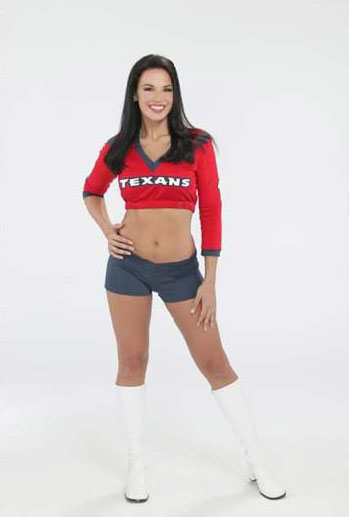From sidelines to school desks; Texan cheerleader has educational impact
By Kim Hogstrom
Contributing writer
Your Houston News
September 12, 2012
The year 1997 was a bleak one for football fans in Houston.
The city’s home team, the Houston Oilers, packed up and moved to Tennessee, leaving many here with nothing to celebrate. It took nearly five years for our orphaned fans to again enjoy the excitement and thrill of rooting for a Houston team.
(Note: Despite the citywide distress over losing football, defections of loyalty to the Dallas Cowboys were as scarce as hen’s teeth. There are some things Houstonians just will not do.)
And a few were not inclined to morn the loss at all.
“Who needs the Oilers?” some asked. “After all, what does a football team really contribute to a city?” But most knew: In addition to a big shot to the local economy, teams contribute in a thousand less-quantifiable ways – from role models for our children to civic pride; from examples of fitness to plain, old fashioned fun.
So, when the new Houston Texans finally stormed onto the field in 2002, fans were ready to celebrate and if the new team was not enough, we also had our stunning, new Reliant Stadium to do it in. The thrilling opening season game was held in September 2002 and played against Houston’s nemesis: the Dallas Cowboys.
 “Walking onto the field that day was amazing,” recalls Amber Benn, a Texans cheerleader who performed at that very first game. “Everyone attending was given a Texans towel to wave and the noise of the crowd was so loud. It was incredible. And the Texans won, 19-10!” she exclaimed with evident joy at the memory.
“Walking onto the field that day was amazing,” recalls Amber Benn, a Texans cheerleader who performed at that very first game. “Everyone attending was given a Texans towel to wave and the noise of the crowd was so loud. It was incredible. And the Texans won, 19-10!” she exclaimed with evident joy at the memory.
Much planning went into that inaugural game; before there was an official football team, the Texans amassed its squad of official cheerleaders. Tryouts were held in August 2001, allowing the 34 selected women a year to learn.
“Practicing, training, cheering and appearances presented a demanding schedule,” recalled Benn with a laugh. The young athlete was chosen for the squad while also working full time. She was the Houston SPCA’s Humane Educator and traveled to schools throughout the metroplex to teach pet care and notably, compassion, to children from first through 12th grades. Benn’s days often started at 7 a.m. at the animal shelter and, with the addition of cheering practice, ended at 10 p.m.
“It was grueling,” the good-humored Benn laughed again. “But somehow, we did it. The time commitment for cheering is a huge one. In addition to the games and practices, we were required to appear at special events. It was a challenge, but all the girls either worked full time or were full-time students, and we all did it. It was still an incredible experience.”
Having secured a place on the squad in 2001, Benn had to try out again each subsequent year, and each year, she was chosen. The young woman was selected from many thousands of hopefuls for four years in a row.
(She didn’t try on the fifth.)
“I started studying dance when I was a child, so dancing was comfortable to me,” the humble Houstonian stated to explain her success.
Although Benn graduated from the University of Houston with a degree in biology, she learned that she had a knack for teaching through her work at the HSPCA. Today, Benn can be found teaching math at Hamilton Middle School in Houston’s Heights where she’s also the coach of Hamilton’s cheer leading team.
Apparently, Coach Benn is having some impact.
“Cheerleading is really fun,” said Hamilton’s cheering team captain, Alejandra Licon. “It has helped me a lot. I used to be shy, but I can speak to people now. I have more confidence,” the bright teen stated.
“I thought I was in shape before I joined,” added team member Kennedy Edwards. “But thanks to cheering and the coach, I’ve learned that I can do whatever I set my mind to, and I have a lot more energy to do it,” she concluded with a smile.
“I love teaching, it’s so rewarding,” Benn said. “As a cheerleading coach, I deal with a lot of teen girls. I try to instill professionalism in each, and teach appropriate behavior and choices.
The girls wear their uniforms at school so all the other students know who they are, and I help them recognize that they’re role models.
“There are requirements to remain on the team, of course. They have to observe attendance and behave appropriately, and they have to keep their grades up. But mostly, I hope I help them learn who they are and who they want to be, to help them become happy, healthy adults,” Benn concluded.



